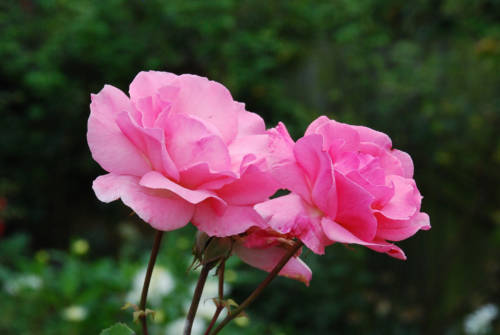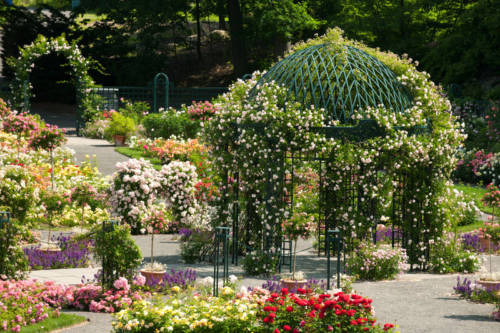An Interview with NYBG Chief Rosarian Stephen Scanniello
Stephen Scaniello has made a reputation for himself as a storyteller and spitfire authority in the world of roses. As the Chief Rosarian at the New York Botanical Garden, our team first became aware of Stephen’s knowledge and passion for flowers when he was being honored last year at the NYBG’s Annual Rose Garden Dinner. Later, we were so inspired that we had him speak at the first annual GC Floral Salon. A few months back, we caught up with Scaniello to discuss hybrids, the New York Botanical Garden, and how he became one of the nation’s most celebrated rosarians.
GC: What was your first experience with gardening?
SS: I grew up in North Jersey, and my Irish aunt would always prune our roses on St. Patty’s Day– she had one rosebush, and when she was all finished pruning she’d take out her lipstick and smear all the petals with her red lipstick. That left an impression on me. But it wasn’t till I accidentally got a job at Brooklyn Botanic Garden that I became a gardener.
GC: How did you accidentally stumble upon that?
SS: I was working at a medical lab at the time, and I got my degree from Lebanon Valley College in Biology. I really wasn’t very inspired to go anywhere with it. I didn’t know what to do, so I came home and ended up with a job at a medical lab. I was making artificial arteries from human umbilical cords, which sounds really fascinating– but after a week it’s excruciating.
I was an amateur photographer, too, so they sent me back to night school at School of Visual Arts in Manhattan, and there I met somebody who worked at Brooklyn Botanic Garden. She said, “You know, we have an opening for a teacher, but we want somebody who has a biology background rather than plants.” So I went and put on my best polyester suit on my twenty-sixth birthday and I got the job. From there, I worked my way up.
GC: That’s not the sequence of events that I would have guessed.
SS: Well yeah, actually I’m training to have a degree in horticulture. I study under Queen Elizabeth’s gardener– I’m the accidental gardener. The day I became the Rosarian at Brooklyn Botanic Garden, it was essentially because nobody wanted the position and they came to me and said, “You wanna try it?” Sure. I knew nothing about roses. But I was there for almost twenty years, and I learned something.
GC: What brought you over to the New York Botanical Garden?
SS: I left Brooklyn in ’98 and focused strictly on the private world while I did some more writing. But I was really, really missing the interaction with the public, and one day the New York Botanical Garden called me and we talked about it, and I said sure, I’ll give it a try.
GC: Did you have a familiarity with their setup just from being somewhat local? Could you have guessed what working for the New York Botanical Garden would be like?
SS: Yeah, I did. I’ve known the head gardener there since I started with roses, so we go way back and I felt very comfortable slipping into this garden and taking charge. I knew Todd Forrest as well, too. So I felt very comfortable and very ready to be back in the public world.
GC: We see the phrase “sustainable rose gardening” thrown around a lot and I would love to know, for you guys, what that means.
SS: To tell you the truth, it’s not a phrase I’m very comfortable using because I don’t really understand it other than knowing that it’s a great title. I look at it more as “common sense gardening”. It’s more practical. Instead of taking the approach that ‘these are roses and you must spray them’, it’s more about going out into the garden and observing what’s happening out there with the roses, and keeping good horticultural practices intact– working with the roses as a plant rather than as a showcase. Before I got there, the so-called sustainable approach wasn’t put into practice. I took out all the roses that required excessive tampering and replaced them with roses that are much more suitable for our climate; those that can tolerate less tampering, less coddling.
“A good thing to remember is that there are thousands of roses out there, but not every rose is for every garden. So you need to choose wisely.”
Some of the roses that I grew up with in my childhood I don’t see anymore because they required a lot of spraying. But there are new roses that are just phenomenal. One of the other issues we deal with to make sure this works is to ensure that there’s proper pruning. Pruning is done to promote plant health and soil health…We don’t dump fertilizers into the garden, which is the old, traditional method. Instead we add things to the soil that will promote a healthy soil condition, which in turn promotes strong root growth. Strong roots, healthy plants, better flowers.
A good thing to remember is that there are thousands of roses out there, but not every rose is for every garden. So you need to choose wisely.
GC: Do you have any stories behind NYGB’s rare rose acquisitions?
SS: Oh, absolutely. I’m the president of the Heritage Rose Foundation, and that’s a group that is completely about preservation, education, and conservation of roses–roses that are part of our history, part of our horticultural legacy, and roses that provide the genetic material that produce the roses of today that are easier to grow.
One rose that we at the Heritage Rose Foundation call Belfield was found in Bermuda. Bermuda is known to be a great resource for unusual roses, roses that were left behind during various population shifts. Some great roses there have survived, because in Bermuda they can’t water their gardens so only these roses flourish. Belfield is thought to be– though we can never really 100% prove it– a rose that was lost in the nineteenth century. That rose was called “Slater’s Crimson China” and first came to the western world from China around 1790 with the tea trade. Westerners found it and brought it, but it was known to be in China for centuries prior to that. You can even see it in ancient Chines manuscripts– a little red rose with very loose petals. Europeans had never seen a rose that looked like this before, and they had never seen a rose that performed like this in that it blooms continuously. The English called it the “ever-blowing rose.” If it was kept in a conservatory in the winter, it would continue to flower.
It was eventually discovered that it was a very potent father rose and a very potent mother rose. So it is said today that “Slater’s Crimson China” is basically the great-great-great-grandfather of all red roses, and we think that Belfield is this rose. I think Peggy Rockefeller is the only botanic garden that has it growing.
GC: Do you have a personal garden? What do you grow?
SS: It’s a mix of everything. My partner and I own a house in South Jersey in a town called Barnegat, and it’s a little old house parts of which date back to the 1700s. The garden dates back to 1997. I’ve got the musk rose, I’ve got Blue China rose, the little red rose from Slater’s Crimson… I’ve got some very modern ones, we have a lot of perennials, we have a vegetable patch with tomatoes, garlic… We also have a grandson who loves to pick blueberries, so my blueberry bushes grow wild. I have apples and lemon trees… All that sounds very fancy, doesn’t it? I consider ourselves plant collectors, which makes for a very cool garden.
GC: What are your favorite nurseries for roses?
SS: I think what’s important is to keep that goal in mind that not every rose is for every garden. Know where the roses are coming from, basically, and that’s the first thing. There’s one nursery I like a lot in New England called Roseland. Roseland Nursery in Acushnet, Massachusetts. It’s a great place to go to pick up roses. I’ll drive up there from New York if I know they have the rose that I want. They grow them so well– as opposed to a box store which is kind of gets them in and pushes them out. I know these guys take care of their roses.
I also encourage people to buy roses online. There are great nurseries out there that have wonderful roses, and one of them is Nancy’s Antique Rose Emporium in Texas. Another one is Roses Unlimited in South Carolina. There’s also one in Florida called Rose Petals Nursery. Rose Petals has that little red rose from China, from Bermuda. What I like about those three nurseries is that they sell you roses that are propagated on their own root system. And that really is important– you may start with a smaller plant, but in the long run they grow stronger and they grow like a perennial.






































